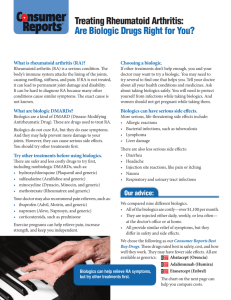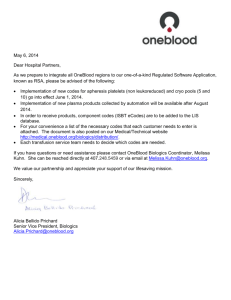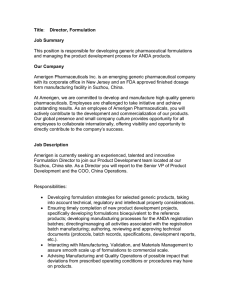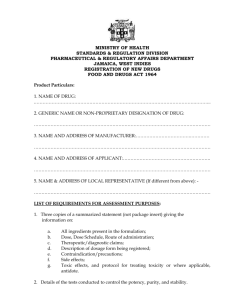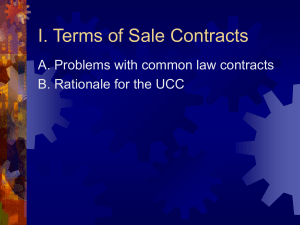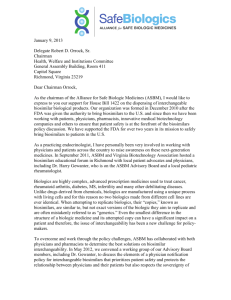Follow-on Biologics: Will the New Biologics Price Competition and Waxman-Hatch 1984 Expectations?
advertisement
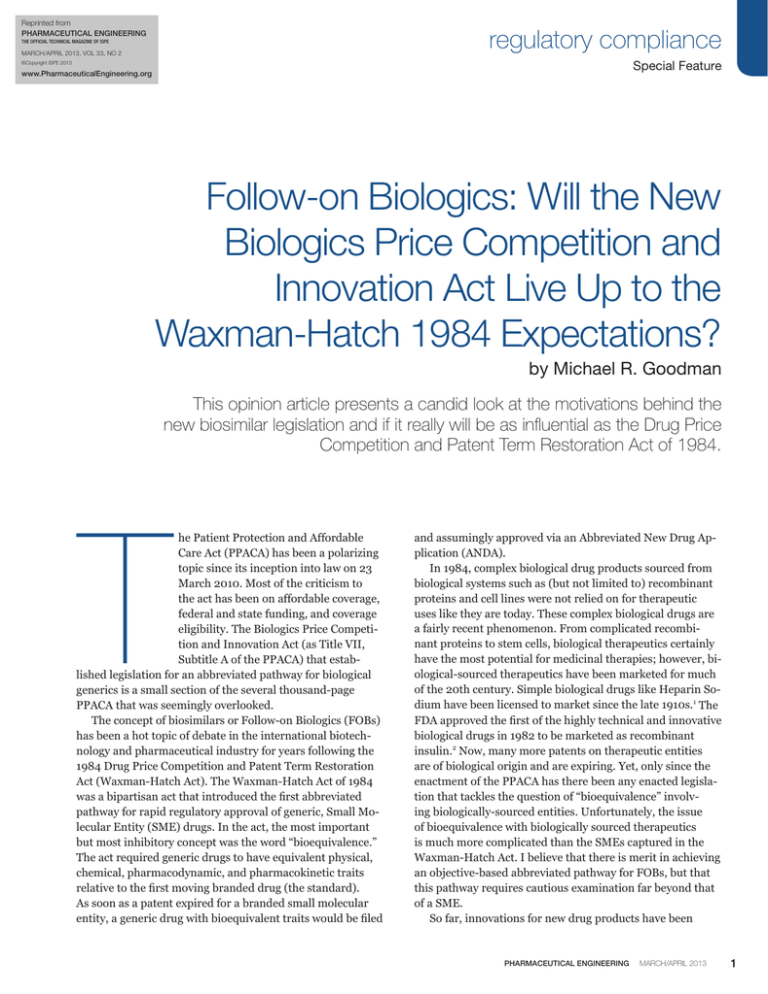
Reprinted from PHARMACEUTICAL ENGINEERING regulatory compliance The Official Technical Magazine of ISPE March/April 2013, Vol 33, No 2 Special Feature ©Copyright ISPE 2013 www.PharmaceuticalEngineering.org Follow-on Biologics: Will the New Biologics Price Competition and Innovation Act Live Up to the Waxman-Hatch 1984 Expectations? by Michael R. Goodman This opinion article presents a candid look at the motivations behind the new biosimilar legislation and if it really will be as influential as the Drug Price Competition and Patent Term Restoration Act of 1984. T he Patient Protection and Affordable Care Act (PPACA) has been a polarizing topic since its inception into law on 23 March 2010. Most of the criticism to the act has been on affordable coverage, federal and state funding, and coverage eligibility. The Biologics Price Competition and Innovation Act (as Title VII, Subtitle A of the PPACA) that established legislation for an abbreviated pathway for biological generics is a small section of the several thousand-page PPACA that was seemingly overlooked. The concept of biosimilars or Follow-on Biologics (FOBs) has been a hot topic of debate in the international biotechnology and pharmaceutical industry for years following the 1984 Drug Price Competition and Patent Term Restoration Act (Waxman-Hatch Act). The Waxman-Hatch Act of 1984 was a bipartisan act that introduced the first abbreviated pathway for rapid regulatory approval of generic, Small Molecular Entity (SME) drugs. In the act, the most important but most inhibitory concept was the word “bioequivalence.” The act required generic drugs to have equivalent physical, chemical, pharmacodynamic, and pharmacokinetic traits relative to the first moving branded drug (the standard). As soon as a patent expired for a branded small molecular entity, a generic drug with bioequivalent traits would be filed and assumingly approved via an Abbreviated New Drug Application (ANDA). In 1984, complex biological drug products sourced from biological systems such as (but not limited to) recombinant proteins and cell lines were not relied on for therapeutic uses like they are today. These complex biological drugs are a fairly recent phenomenon. From complicated recombinant proteins to stem cells, biological therapeutics certainly have the most potential for medicinal therapies; however, biological-sourced therapeutics have been marketed for much of the 20th century. Simple biological drugs like Heparin Sodium have been licensed to market since the late 1910s.1 The FDA approved the first of the highly technical and innovative biological drugs in 1982 to be marketed as recombinant insulin.2 Now, many more patents on therapeutic entities are of biological origin and are expiring. Yet, only since the enactment of the PPACA has there been any enacted legislation that tackles the question of “bioequivalence” involving biologically-sourced entities. Unfortunately, the issue of bioequivalence with biologically sourced therapeutics is much more complicated than the SMEs captured in the Waxman-Hatch Act. I believe that there is merit in achieving an objective-based abbreviated pathway for FOBs, but that this pathway requires cautious examination far beyond that of a SME. So far, innovations for new drug products have been PHARMACEUTICAL ENGINEERING March/April 2013 1 regulatory compliance Special Feature too slow to meet the demand generated by an increasing United States and European population and the new drugs manufactured are not capable of reaching the entire effected populations. In 2004, the European Medicines Agency (EMA) examined possibilities of a generic biological drug abbreviated pathway and published concept papers on the generic biological entities that showed similar effects to the original biological entity. In 2005, the European Medicines Agency (EMEA) approved novel FOB (referenced as biosimilars) guidelines to encourage competition between pharmaceutical companies. The European Universal Health Care system was considered for allowing biosimilars to be approved through a fast-track regulatory process. The governments in the European Union (EU) hypothesized that the countries could create competition and spend less without compromising safety and efficacy.3 The debate on biosimilars in the United States was and is still about “how similar” could a FOB be to a referenced biological entity. “ ...understanding the true difference between a small molecular entity and a biological helps elucidate the reason why bioequivalence is not an option. The other problem with FOBs originates from the proprietary and nonproprietary steps in the respective biologic’s manufacturing process. It is given that most biological entities are protected under the United States Patent and Trade Office (USPTO). As part of the numerous intellectual property associated with one biological entity, the process of manufacturing is generally captured in the claims of one or more of the patents. What are not included in the claims are specific characteristics related to the appropriate facilities, utilities, and equipment. These process-specific tangibles are a critical factor in method and process transfer that in many cases, companies send the exact equipment from the original facility to the new facility to maintain process equivalence. This option is not feasible when the patent-holding first mover is in direct competition with a generic manufacturer. In order to understand the ramifications of this new legislation, it is important to understand the difference between biological and synthetic entities and why reproducing biological entities are highly variable even from process to process at the same facility. Unlike small molecular pharmaceuticals that are organically synthesized in a lab, 2 March/April 2013 PHARMACEUTICAL ENGINEERING a biological is an Active Pharmaceutical Ingredient (API) composed of sugars, proteins, nucleic acids, or a complex of them. They are produced from animal, plant, microbiological, or viral crude material. The FDA division that monitors and evaluates biologics is the Center for Biologics Evaluation and Research (CBER). Generally, CBER is responsible for monitoring pharmaceuticals, including vaccines, blood and blood components, allergenics, somatic cells, gene therapy, tissues, and recombinant therapeutic proteins.4 Under normal circumstances, a new biological drug application is filed in the United States under a Biologic License Application (BLA) and approved by CBER. The EMEA did not redefine generic drugs to be similar, but not equivalent. Instead, it made an exception to their accelerated approval process. The EMEA defines a generic medicinal product as having: • The same qualitative and quantitative composition in active substances as the reference product • The same pharmaceutical form as the reference medicinal product • Whose bioequivalence with the reference medicinal product has been demonstrated by appropriate bioavailability studies5 The EMEA recognized that current analytical technologies are not able to fully characterize the large and complicated biologics. Biosimilars could not be completely characterized according to the same processes for the EMEA fast-track approval process for small-molecular genetics. In 2004, the EMEA explicitly made an exception to the 2001 directive. The European Directive 2004/27/EC was written to address “biological medicinal products” that are not equivalent, but similar. The directive eased the specification for a biological to be similar. It states that if there are differences in raw materials or manufacturing process between a pioneer biological drug and its follow-on, pre-clinical or clinical trials relating to these conditions must be provided.6 The 2004 European Directive requires comparability studies between the similar biological drugs. They compare physio-chemical, biological, pre-clinical, and clinical comparability. The requirements for clinical trials are based on pharmacovigilance, automatic substitution with the pioneer drug, quality, and efficacy.3 The EMEA took strides to support biosimilars into the European market; however, the pathway is more similar to a pioneer drug application than that of a generic small molecular entity. Regulatory directives guiding the EMEA on FOBs are more open-ended to allow the agency to structure rigorous pre-clinical and clinical trials on a case-by-case basis. I believe that the EMEA’s directives for defining acceptance criteria case-by-case are the best way to approve FOBs, but does not address the main concern for significantly more and cheaper biosimilars regulatory compliance Special Feature clinical trials on safety and efficacy of a marketed drug product. Crude biological products are not synthesized in the lab. As previously stated, they are sourced from animal, plant, microbial, or viral origins. In contrast to typical non-biological drugs, biologics are 100 to 1,000 fold larger and more complex. The biologicals are also highly susceptible to variations in species, geographical origin, and even dietary activities of the biological source. The impurity profiles of a synthesized small molecular entity can be determined from picture diagrams that predict and characterize intermediates throughout each step of an organic synthesis process. Likewise, the impure intermediates can be drastically reduced by various chromatography methods. In most cases, the final step in the organic synthesis ends with a purification process that purifies the desired API from what little is left of Figure 1. A visual representation of the tertiary structure of a protein compared to a small the impure intermediates that followed molecular entity. through the process. Impurity profiles for biologics will always vary from one source to another. Porcine material from reaching a larger portion of the afflicted European populaChina will have different impurities than the same material tion. However, understanding the true difference between sourced in the United States. Companies cannot reasona small molecular entity and a biological helps elucidate the ably prove that two different sources for the same biological reason why bioequivalence is not an option. entity can have the same impurity profile, i.e., impurities from food, pesticides, antibiotics, environment, and infecInterchangeability and Analytical and tions (viral and bacterial). Currently, the Waxman-Hatch Act Scientific Considerations would be infringed on by approving a FOB based on “bioThere are fundamental differences between the small-molequivalence.” FOBs cannot be defined as equivalent between ecule and biological APIs. The FDA has traditionally been two manufacturers when there are unknown variables that conservative in their interpretations of biologics and distincannot be assessed without nonclinical and clinical safety guishing them from small-molecule APIs that are formulated and efficacy trials. into drug products. However, the Agency correctly did not The size and stereochemistry of generic small molecules plan to be constructionists to the FD&C and Waxman-Hatch allow for precise analytical characterization and detection Acts. The root of the problem between the distinguishable when small changes arise in the manufacturing process. APIs lies in their distinctive characteristics. A single chemical formula can correctly characterize the The Waxman-Hatch Act of 1984 was generated around molecular structure and composition of a small molecule small molecules that are synthesized in the lab. These smallmakeup of tens to hundreds of atoms.7 Analytical technolomolecule APIs start and end by in-lab organic synthesis and purification. Included in the Waxman-Hatch Act was anothgies are not yet capable of conclusively detecting small er alternative pathway for modifications to marketed drug changes and variations to a biological matrix. For example, products that do not entirely circumvent the need for clinical a Class 1 recall performed in early 2008 found that filler was trials, but on a subjective, case-by-case basis, reduces the introduced upstream in the biological purification process. length and required participants generally assumed in a full The physical similarities between the filler and the drug subPhase Ito III clinical trial procedure for a new molecular stance were astonishing and could not have been detected entity. The 505(b)(2) pathway enables drug manufacturers by the normal analytical procedures used for final product to circumvent some or all of the early phase clinical trials by testing. This example of an undetectable impurity is only one referencing previously performed applicable nonclinical and example of how critical it is to understand the complexities PHARMACEUTICAL ENGINEERING March/April 2013 3 regulatory compliance Special Feature and variability of changes to a biological matrix. There are substantial differences between two biologics that are classified as “similar;” however, viral epidemiology has been a focal point of the FDA. The major concern is the viral load in varying biologics and the potential for those viruses to mutate from non-zoonotic to zoonotic. Complete viral profiles in certain biological sources are not possible. The requirement is to have a means of monitoring viral epidemiology. Different geographical locations have varying epidemics. Hypothetically, if a pioneer drug had an associated FOB, once a new virus emerges, the two drugs would not be equivalent and impose different safety risks. There can be multiple avenues to take when synthesizing an organic small-molecule. In many cases, patents on synthetic processes for organic intermediates force other API manufacturers to find different routes to synthesize the desired end product. Unless there is a patent on the final product and that patent has not expired, the small molecule can be synthesized by multiple synthesis routes. Additionally, generic development of small molecules should have a more efficient development process than the innovated API. The purpose of a generic drug (and thus enactment of the Waxman-Hatch Act) is to market cheaper, bioequivalent drug products that reach a larger population of the afflicted United States populous. The development process for biologics can be intrinsic and complicated. Steps for impurity inactivation, protein activation, therapeutic properties, and potencies are all tied into the manufacturing process. For a biologic to be equivalent or even similar to the pioneer drug, the process must be completely known and mastered. Unless the pathway for the biologic has somehow become public, information pertaining to the manufacturing instructions would be proprietary. Unless legislation is passed forcing drug master files to become public knowledge, the feasibility of achieving an equivalent or similar biologic is very low. Like generic small molecular entities, manufacturers of FOBs are trying to prove that their generic is “interchangeable” with the brand name biologic. According to the FDA, a FOB will be considered interchangeable if: • It is biosimilar to the reference • It is expected to have the same clinical result • It can be switched with the reference during multiple administrations without a risk to safety In the draft guidance “Guidance for Industry – Scientific Considerations in Demonstrating Biosimilarity to a Reference Product,” the FDA recognizes that even a minor difference between a FOB protein to a reference can significantly affect the safety, activity, potency, and purity of that protein. Even examples of purified sugars from animal sources will have different chemical and physical characteristics (such as 4 March/April 2013 PHARMACEUTICAL ENGINEERING varying positions of glycosylation on the sugar) dependent on the origin of the source. These variables make proving interchangeability nearly impossible. It is believable and even feasible that FOBs can show the same activity and potency of the reference; however, I believe that even our most capable analytical equipment and techniques do not draw a complete picture of a reference or the FOB. Additionally, the activity of the reference to the FOB may be similar in one pharmacological aspect, yet significantly different in another, unexamined system. To prove interchangeability, even biosimilarity, the FOB must show similarities in pharmacodynamics and pharmacokinetics in the entire system and not just the targeted part of that system. This nonclinical and clinical testing may even require more testing than what the branded drug underwent during the original clinical and nonclinical studies. This testing along with differing viral and microbial adventitious agents and even impurities with the same retention times as a known impurity make it nearly impossible and possibly as costly as developing and characterizing the branded drug product. Yet in the draft guidance “Guidance for Industry – Quality Considerations in Demonstrating Biosimilarity to a Reference Protein Product,” the considerations for analytical similarities between the reference and the FOB should be based on the “known” quality attributes and performance characteristics of the specific reference product and not more extensive analytical studies on the currently unknown attributes. Unfortunately, it can be argued that the unknown quality attributes may prove vital, but remain unknown as to the overall “biosimilarity” of the reference and the FOB. Economic Considerations In 1960, Cutter Laboratories was sued for negligence and liability pertaining to their polio vaccine. The Gottsdanker v. Cutter case opened the floodgates for unreasonable lawsuits against pharmaceutical companies. After in depth litigation, the jury came back with the verdict that introduced “liability without negligence.” This judgment has been used for more than 60 years to sue pharmaceutical companies for supposed side effects to their drugs. Even if there were no negligent and unlawful acts performed in the process, the pharmaceutical company still may assume liability. The distinction between liability and negligence increases administrative costs to the pharmaceutical industry. When a pharmaceutical company loses or settles on a lawsuit, insurance pays the lawsuits. The insurance companies recoup their losses from tort by charging high premiums to the pharmaceutical companies. This causes the pharmaceutical companies to raise the prices of their drugs to cover the costs of the high insurance premiums. For example, in 2002 Merck was liable for supposed side effects from their drug Vioxx costing the company in total $4 to $6 billion. Litigations continued even after a 120-person study of Vioxx regulatory compliance Special Feature showed post-operation recovery with potential for a decrease in post-operational narcotics. The study showed no complications for using Vioxx.8 The malpractice attorneys are the only beneficiaries from these class action lawsuits. Regardless of successful clinical studies and Biologics License Application (BLA), New Drug Application (NDA), or Investigational Device Exemption (IDE) approval, drug and medical device companies have a high insurance premium to protect the company from lawsuits. The newly innovated technologies in the biological field have the highest risk for these lawsuits. The technology is so new and state of the art that there is certainly the potential for liability. Product liability is only part of the economic disincentive with formulating a FOB. According to the Generic Pharmaceutical Association (GPhA), the average cost of pioneer biological drugs to the consumer is $93.24 a day and even though the GPhA predicts that marketing FOBs will contribute to savings and improve access to health care,9 the research performed by the Federal Trade Commission (FTC) does not correlate with these predictions. The FTC studied the FOBs competitors in Europe and the US. The studied concluded that the market of FOBs resemble brand-to-brand competition rather than the brand-to-generic drug competition. It is important to realize all the intrinsic parts of manufacturing biological drugs.9 Generally, pharmaceutical companies do not only rely on intellectual property to protect years of research and development, pre-clinical, and clinical trials. Tacit and codified knowledge (trade secrets) are commonly relied on in manufacturing instructions. Those secrets must be replicated in order to manipulate the biologic to possess therapeutic equivalence with the pioneer biological entity. Using current analytical techniques, i.e., Nuclear Magnetic Resonance (NMR) spectroscopy and chromatography, enables generic pharmaceutical companies to uncover the molecular structures of small-molecular APIs. Then by retro-synthetic analysis, process development assets can formulate processes to synthesize bioequivalent molecules. The process is anticipated to take three to five years to develop and cost between $1 and $5 million. On the other hand, because of so many “unknowns” in the process, FOB products commonly take eight to ten years to develop at a cost of between $100 and $200 million. This high cost of entry discriminates against small biotechnology companies that may have the analytical capabilities, but not nearly enough capital to market a FOB.9 The high requirements to show interchangeability and even biosimilarity of a FOB to the pioneer drug product stunts the price advantage a generic drug would expect to have. Even before the PPACA, the FDA had publically supported legislation for abbreviated drug applications for follow-on biologics. However, Dr. Woodcock described interchangeability as an undefined variable that is impacted at the discretion of the doctors that prescribe the biologi- cal therapies.10 The ideal qualities that lead physicians to prescribe generic small-molecule drugs do not apply to biologics. Small differences in protein folding between two companies, activity, etc. will influence a physician’s decision to prescribe a pioneer drug over its FOB. The lack of interchangeability will enable the branded manufacturer to continue charging monopoly prices and still outsell competition. From a socioeconomic standpoint, when multiple generic competitors enter the small molecule drug market, the cost can decrease up to 80%; however, anticipating more than two or three FOB manufacturers to enter the same market is not realistic. The more realistic competitive structure between FOBs and pioneer drugs would be more brand-tobrand than brand-to-generic. Ultimately, the competition would force the brand drug to charge less than monopoly prices, but would only reduce at a maximum of 30%.10 The brand manufacturer reaps considerable advantage for being the first mover over second and late movers into the market. The last factor is the risk of unregulated tort stunting companies from entering the biologic drug market. By factoring in these three current issues, the risks of developing and marketing FOBs outweigh the rewards. The Pathway The 351(k) application provides the new abbreviated pathway for FOB approval. The pathway in its primitive form is similar in concept to the 505(b)(2) pathway. The 351(k) application currently requires many of the same drug evaluations that a Biological Licensing Application requires except for a subjectively abbreviated human clinical trial. The FDA intends to consider the “totality of evidence” in a FOB application. This includes comparative studies to a reference biologic (generally the brand drug). The current guidances on how to approach the comparative studies are still in draft; however, some of the major considerations necessary to determine biosimilarity are captured in Figure 2.12 The proposed 351(k) pathway takes a conservative approach to FOB approval. Although I agree with the approach, the testing is still somewhat subjective and the extensive analytical testing will inevitably be costly and taxing on the generic developer. Considerations There must be a way to accomplish the similar achievements that the Waxman-Hatch Act has over the last 30 years. I do not believe that the current process for FOBs will accomplish what it was set out to do. I also do not believe (as some do) that eliminating Intellectual Property (IP) or even further limiting the scope of patents is the answer. Instead, the legislation should change directions and attack the problem starting with the patent assignees rather than the second PHARMACEUTICAL ENGINEERING March/April 2013 5 regulatory compliance Special Feature and its FOB. Currently, the United States has groundbreaking biologics that are not available or obtainable by most of the patients that need them. In this case, creating competition was not the right move. Instead, the brand drug manufacturer should have been given incentives to play a role in bringing FOBs to market. This way, FOBs would be “more similar” to the reference by filling in many of the gaps that generic FOB manufacturers are currently facing. With more and “better” FOBs on the market, many more patients can get what they need to mitigate or even remediate the indications they struggle with. It is time we taper back the idea of forced (yet irrelevant) competition and try and achieve a better sense of collaboration in the industry. Conclusion Figure 2. The subjective 351k biosimilars pathway.12 and late movers that manufacture the generics. In other words, there must be a renewed focus on the end user safety rather than forced competition between pharmaceutical and biotechnology companies. I should disclose that I bleed capitalism and subscribe to the United States Patent and Trademark Office’s (USPTO’s) mission statement; however, the USPTO’s purpose inherently discourages mass production of products that need to reach the end users. Patent claims bring enough light to the process to encourage development of similar drug products by late movers. Unfortunately (for the generic manufacturers), those claims do not give enough insight into much of the intrinsic aspects of the process for reverse engineering a biologic capable of interchangeability. Understandably, this was taken into account by acknowledging that a generic biologic is “good enough” as “similar.” The current legislation encourages generic manufacturers to fill in the gaps in IP claims by guessing. These gaps will inevitably and significantly raise developmental costs of the potential FOB and these costs will be passed to the patient. All that is left is a high costing FOB that is similar, but not equivalent to the reference. To mitigate these significant issues, the drafters should have focused on transparency between the branded drug 6 March/April 2013 PHARMACEUTICAL ENGINEERING The legislation to enable an abbreviated pathway for FOBs was inevitable. I caution the enthusiasts that FOBs will not have the same impact on cost reduction that bioequivalent generic SMEs had following the ratification of the WaxmanHatch Amendment in 1984. Biologics are too complicated to compare to SMEs. The procedures used to reverse-engineer synthesized molecules cannot be performed for biological entities with facets that in many cases, are independently affected by intrinsic and even unknown parts in the process. It is naïve to classify a biological entity as similar in chemical (2°) characteristics and structure, but has differences in the tertiary (3°) structure. This alone affects the activity of that biologic and could be arguably a completely different protein structure. An unmentioned risk in all biological entities is the concern for adventitious agents. Viral and other microbial contamination is a risk that can only be mitigated, but not necessarily eliminated. The microbial loads in the original biologic may be acceptable, but the FOB microbial loads may be too high or even more likely, unknown to even exist in the formulated product. The disparity in possible adventitious agents is another cause for concern with FOBs. Although this opinion is seemingly pessimistic, there is a need for an increase in supply of many of the new biological entities and I do not see how the legislation will significantly help. The current manufacturing processes for biologics can be slow and expensive. This problem is the underlying source for the need for other manufacturers to be able to manufacture and market similar drugs that act on the same patient indications. Allowing generic biologics to enter the regulatory compliance Special Feature market (assuming the biosimilarities are acceptable) will add some level of competition, but more importantly, reach a greater number of the populous that a single drug manufacturer could not possibly accommodate. Another concern with this new pathway is how biosimilarity determined and by whom. Hopefully the takeaway is that determining biosimilarities is subjective and not objective because the analytical, nonclinical, and clinical testing probably is not comprehensive enough to entirely characterize the similarities and differences between the reference and the potential FOB. The answer is that the FDA is largely responsible for deciding if two biologics are similar. Is this a responsibility that the FDA can and is willing to accept? As of September 2012, the FDA had not received a 351(k) application although there were 11 INDs and 30 pre-IND meetings with the FDA pertaining to potential FOB applications.12 In general, I believe an abbreviated pathway for FOBs to enter the market was necessary; however, the motivation surrounding the pathway should not have been to reduce the cost by creating competition. In fact, the work required to prove interchangeability and/or biosimilarity is so comprehensive that providing “meaningfully cheaper” alternatives to the branded generic is not feasible. The focus of the legislation should have been to motivate and even incentivize companies with branded biologics going off patent to cheapen their product and collaborate with companies that are willing to manufacture biosimilars. The primary goal should be to manufacture more acceptable product and have a cost reduction be a welcomed byproduct. The new biosimilar abbreviated route of approval will not significantly impact the amount of available therapies to patients nor reduce the drug shortages experienced when a manufacturer cannot produce enough or any of the formulated drug product that many people are now dependent on. References 1. Linhardt R., “Heparin: An Important Drug Enters its Seventh Decade,” Chemistry & Industry, Version 2, 1991, pp.45–50. 2. Rubin, Rita, “For Many Biological Drugs, “On the Market” Doesn’t Mean Safe,” USA Today, 2008. 3. Zuñiga, L. and Calvo, B. “Biosimilars Approval Process,” Regulatory Toxicology and Pharmacology, 2009. 4. CBER Vision & Mission, 2009, http://www.fda.gov/ AboutFDA/CentersOffices/CBER/ucm122878.htm. 5 Directive 2001/83/EC of the European Parliament and the Council of 6 November 2001 on the Community Code Relating to Medicinal Products for Human Use, Office Journal of the European Communities, 2001. 6. Directive 2004/27/EC of the European Parliament and the Council of 31 March 2004 on the Community Code Relating to Medicinal Products for Human Use, Office Journal of the European Communities, 2004. 7. PhRMA Scientific Comments for Docket #2004N-0355, Web, Dec. 2009, http://www.fda.gov/OHRMS/dockets/ dockets/04n0355/04n-0355-cr00001-01-vol5.pdf. 8. Horattas, M.C., et al., “Does Preoperative Rofecoxib (Vioxx) Decrease Postoperative Pain with Laparoscopic Cholecystectomy?” The American Journal of Surgery, 2004, Volume 188. pp. 271-276. 9. GPhA. AARP Press Release: AARP “Rx Watchdog Report” Highlights Need for Congressional Action to Provide Generic: Competition for Biologics Competition Would Lower Medicare Part D Costs for Life Saving Specialty Drugs, GPhA Press Release 2008, Web, (Dec. 2009). http://www.gphaonline.org/media/press-releases/2009/02/12/aarp-rx-watchdog-report-highlightsneed-congressional-action-provide. 10. Wroblewski, M et al., “Emerging Health Care Issues: Follow-on Biologic Drug Competition,” Federal Trade Commission Report, June 2009, © Federal Trade Commission. 11. Woodcock, J. “Interview on Follow-on Protein Products before the House Committee of Oversight and Government Reform 2007,” Web, Dec. 2009. http://www.fda. gov/NewsEvents/Testimony/ucm154070.htm. 12. Sherman, Rachel, “Biosimilar Biological Products,” 2012, Biosimilar Guidance Webinar. 13. Malkin, Brian, “Biosimilar Reviews ‘Under-Resourced’ at FDA Woodcock Reports in DIA Meeting”, FDA Lawyers Blog – Frommer Lawrence & Haug LLP 13 Sept. 2012. 14. Follow-On Biologics, Hearing of the Committee on Health, Education, Labor, and Pensions, 2007. About the Author Michael Goodman, MS is a compliance specialist for Compliance Insight. Goodman has expertise in cGMPs, regulatory filings (IND and NDA/BLA), process validation for pre- and post-NDA/BLA active pharmaceutical ingredients and drug product; qualification of facilities, utilities, and equipment; FDA audits; and FDA 483 and Warning Letter responses. He has advised companies that specialize in commercial manufacturing, analytical testing, siRNA and nanotechnology platform development, and human-embryonic and induced pluripotent stem-cell development. He can be contacted by telephone 1-513-860-3512 or email: mike@complianceinsight.com. Compliance Insight, 5850 Boymel Dr. #1, Fairfield, Ohio 45014, USA. PHARMACEUTICAL ENGINEERING March/April 2013 7
